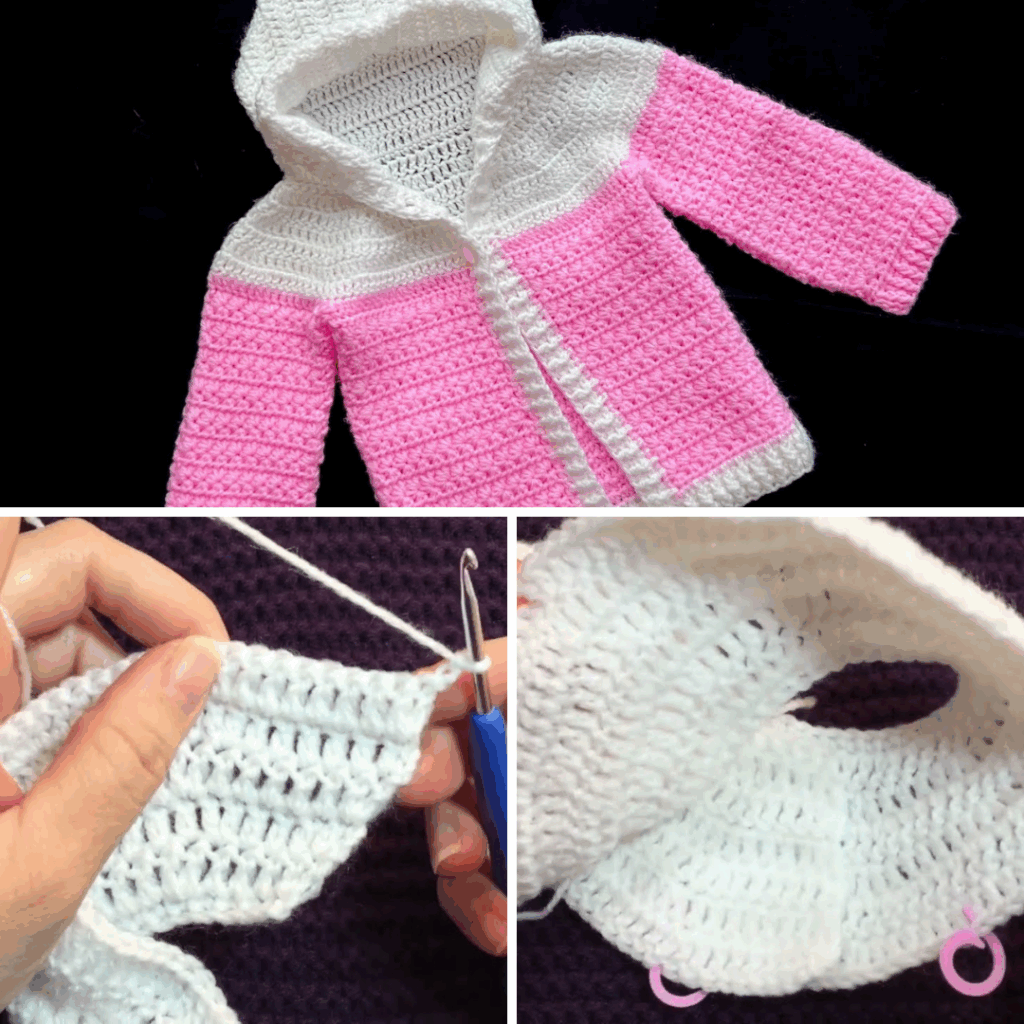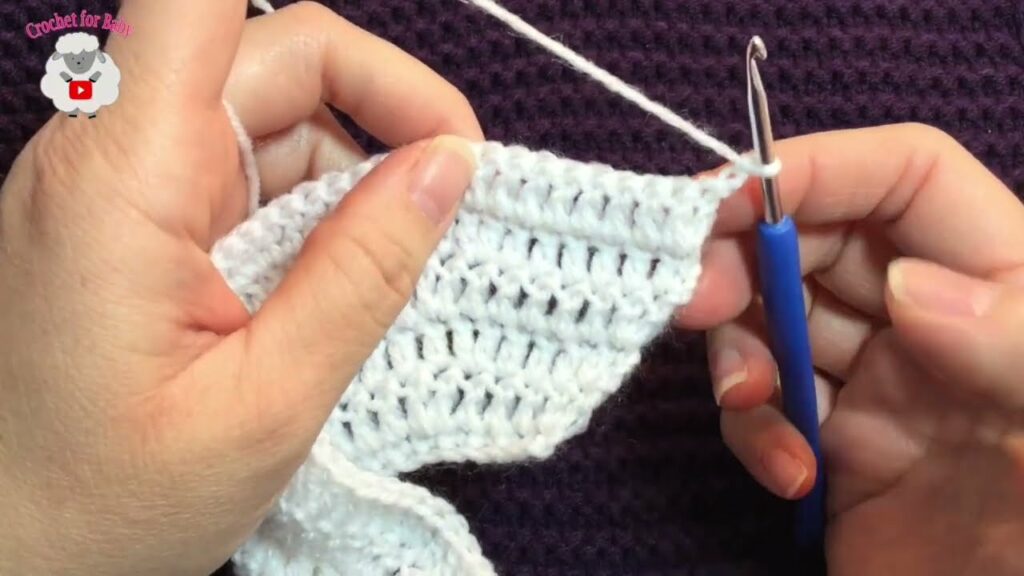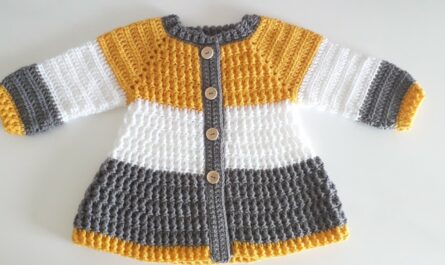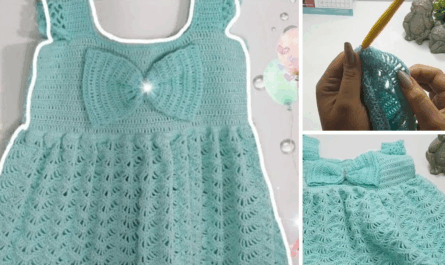A handmade hooded sweater is a classic and cozy staple for any little one, and when you add the beautiful texture of the star stitch, it becomes truly magical. The star stitch, with its intricate, star-like pattern, creates a dense and warm fabric that’s perfect for a baby hoodie. This beautiful design is not only visually stunning but also a rewarding project for crocheters looking to create a cherished, heirloom-quality garment.
This detailed article will guide you through the process of crocheting a star stitch hoodie sweater for baby, sized from newborn to 12 months. This project is ideal for intermediate crocheters who are ready to take on a garment with a unique texture.

1. Why the Star Stitch Hoodie is a Perfect Project
The star stitch hoodie is an ideal choice for several reasons:
- Beautiful Texture: The star stitch, also known as the daisy stitch, creates a thick, textured fabric that is incredibly warm and visually appealing. This dense fabric is perfect for keeping a baby cozy and comfortable.
- Heirloom Quality: A handmade star stitch sweater is a special gift that will be treasured for years to come. The classic design and beautiful texture ensure it will never go out of style.
- Skill Building: This project is a great way to practice more advanced stitches and techniques, such as working with a textured pattern, creating a seamless yoke, and adding a hood.
- Versatile: This pattern can be made in a variety of colors, from soft pastels to bold, vibrant hues. You can even add a contrasting color for the ribbing or a fun, unique button.
2. Planning and Materials
Before you begin, gathering the right materials is the first step toward a beautiful finished sweater.
- Pattern: You will need a pattern for the “Star Stitch Hoodie Sweater” or a similar star stitch garment. Look for a pattern from a reputable designer like “Crochet for Baby” on platforms like Ravelry, Etsy, or popular crochet blogs. The pattern should include a size chart for newborns to 12 months.
- Yarn: A DK (light worsted) or worsted weight yarn is an excellent choice for this project. Soft acrylic yarn is a popular option for baby items as it’s durable, easy to wash, and hypoallergenic.
- Crochet Hook: The pattern will specify the hook size. Make sure you use the recommended size to achieve the correct gauge.
- Gauge Swatch: Making a gauge swatch is crucial for any garment project. It ensures your finished sweater will be the correct size.
- Other Supplies: You will also need scissors, a tapestry needle for weaving in ends, and buttons for the closure.
3. Understanding the Construction
The star stitch hoodie is typically worked in one piece, from the top down. This seamless construction method is a popular choice for sweaters because it allows for easy size adjustments and a beautiful drape.

Common Construction Method: Top-Down, Seamless
- Yoke: The sweater starts with the yoke, which is the top portion covering the chest and shoulders.
- Star Stitch: The pattern will use a specific star stitch, which is a combination of stitches worked together to create a beautiful, textured pattern. This stitch is what gives the sweater its unique look.
- Increases: You will work in rounds, increasing stitches in specific places to create a flat, circular yoke. The increases will form the armholes and shape the top of the sweater.
- Division: Once the yoke is the correct size, you will divide the stitches into four sections: two for the front panels, one for the back, and two armhole spaces.
- Body and Sleeves: From this point on, you will work the body in one piece, continuing with your stitch pattern and skipping the armhole sections. The sleeves are then worked off of the armhole openings.
- Hood: The hood is typically worked separately and then sewn onto the neckline.
4. The Step-by-Step Process (Top-Down)
Once you have your pattern and materials ready, you can start crocheting.
Part 1: The Yoke
- Foundation Chain: You’ll start with a chain that is the length of the neckline, plus a few extra stitches for the button panel.
- Increase Rounds: The pattern will instruct you on how to place increases in each round to create a flat, circular yoke. You will work in rows, turning at the end of each row. These increases will form the armholes and shape the top of the sweater. You will continue to work in rows until the yoke reaches the correct size for the baby’s chest and armholes.
- Divide for Armholes: Once the yoke is the correct size, the pattern will instruct you to divide the stitches into four sections: two for the front panels, one for the back, and two armhole spaces. You will stop crocheting in the armhole stitches for the rest of the body.
Part 2: The Body
- Work in Rows: From this point on, you will work the body in one piece, continuing with the star stitch pattern, but you will only work across the front and back panels. You will skip the armhole sections.
- Create the Body: Continue working in rows until the body reaches the desired length.
- Add a Border: Once the body is the correct length, you can add a simple ribbing (e.g., front post and back post double crochet) to the bottom hem for a professional finish.
Part 3: The Sleeves
- Work in the Round: Once the body is complete, you will join your yarn to one of the armhole openings. You can work the sleeves in the round to avoid seams.
- Continue Pattern: Continue working the star stitch pattern in rounds, decreasing a few stitches every few rounds to create a tapered sleeve shape.
- Create the Cuff: When the sleeve reaches the desired length, you can add a simple ribbing for a clean, finished cuff.
- Repeat: Repeat for the second armhole.

Part 4: The Hood
- Foundation Chain: You will work a new panel for the hood, starting with a chain that is the length of the neckline.
- Work in Rows: You will work in rows, continuing with the star stitch pattern, until the hood is the desired length.
- Attach to Neckline: Once the hood is complete, you will sew it to the neckline of the sweater using a tapestry needle.
Part 5: Finishing Touches
- Button Panel & Buttonholes: A button panel is typically made by working a few rows of single crochet up one of the front panels. You will create the buttonholes by chaining one and skipping a stitch in a row, creating a small hole for the button to pass through.
- Weave in All Ends: Use your tapestry needle to carefully weave in every single loose end.
- Attach Buttons: Sew the buttons onto the opposite front panel.
- Blocking: Blocking is highly recommended. It will even out your stitches, help the star stitch pattern open up and lie flat, and give the sweater a perfect, professional shape.
5. Final Thoughts
Crocheting a star stitch hoodie is a delightful project that results in a gorgeous, one-of-a-kind garment. By breaking the process down into manageable parts and choosing a pattern that suits your skill level, you can create a treasured piece that is both beautiful and a testament to your hard work.
A handmade hooded sweater is a classic and cozy staple for any little one, and when you add the beautiful texture of the star stitch, it becomes truly magical. The star stitch, with its intricate, star-like pattern, creates a dense and warm fabric that’s perfect for a baby hoodie. This beautiful design is not only visually stunning but also a rewarding project for crocheters looking to create a cherished, heirloom-quality garment.
This detailed article will guide you through the process of crocheting a star stitch hoodie sweater for baby, sized from newborn to 12 months. This project is ideal for intermediate crocheters who are ready to take on a garment with a unique texture.
1. Why the Star Stitch Hoodie is a Perfect Project
The star stitch hoodie is an ideal choice for several reasons:
- Beautiful Texture: The star stitch, also known as the daisy stitch, creates a thick, textured fabric that is incredibly warm and visually appealing. This dense fabric is perfect for keeping a baby cozy and comfortable.
- Heirloom Quality: A handmade star stitch sweater is a special gift that will be treasured for years to come. The classic design and beautiful texture ensure it will never go out of style.
- Skill Building: This project is a great way to practice more advanced stitches and techniques, such as working with a textured pattern, creating a seamless yoke, and adding a hood.
- Versatile: This pattern can be made in a variety of colors, from soft pastels to bold, vibrant hues. You can even add a contrasting color for the ribbing or a fun, unique button.
2. Planning and Materials
Before you begin, gathering the right materials is the first step toward a beautiful finished sweater.
- Pattern: You will need a pattern for the “Star Stitch Hoodie Sweater” or a similar star stitch garment. Look for a pattern from a reputable designer like “Crochet for Baby” on platforms like Ravelry, Etsy, or popular crochet blogs. The pattern should include a size chart for newborns to 12 months.
- Yarn: A DK (light worsted) or worsted weight yarn is an excellent choice for this project. Soft acrylic yarn is a popular option for baby items as it’s durable, easy to wash, and hypoallergenic.
- Crochet Hook: The pattern will specify the hook size. Make sure you use the recommended size to achieve the correct gauge.
- Gauge Swatch: Making a gauge swatch is crucial for any garment project. It ensures your finished sweater will be the correct size.
- Other Supplies: You will also need scissors, a tapestry needle for weaving in ends, and buttons for the closure.
3. Understanding the Construction
The star stitch hoodie is typically worked in one piece, from the top down. This seamless construction method is a popular choice for sweaters because it allows for easy size adjustments and a beautiful drape.
Common Construction Method: Top-Down, Seamless
- Yoke: The sweater starts with the yoke, which is the top portion covering the chest and shoulders.
- Star Stitch: The pattern will use a specific star stitch, which is a combination of stitches worked together to create a beautiful, textured pattern. This stitch is what gives the sweater its unique look.
- Increases: You will work in rounds, increasing stitches in specific places to create a flat, circular yoke. The increases will form the armholes and shape the top of the sweater.
- Division: Once the yoke is the correct size, you will divide the stitches into four sections: two for the front panels, one for the back, and two armhole spaces.
- Body and Sleeves: From this point on, you will work the body in one piece, continuing with your stitch pattern and skipping the armhole sections. The sleeves are then worked off of the armhole openings.
- Hood: The hood is typically worked separately and then sewn onto the neckline.
Video part 1 :
4. The Step-by-Step Process (Top-Down)
Once you have your pattern and materials ready, you can start crocheting.
Part 1: The Yoke
- Foundation Chain: You’ll start with a chain that is the length of the neckline, plus a few extra stitches for the button panel.
- Increase Rounds: The pattern will instruct you on how to place increases in each round to create a flat, circular yoke. You will work in rows, turning at the end of each row. These increases will form the armholes and shape the top of the sweater. You will continue to work in rows until the yoke reaches the correct size for the baby’s chest and armholes.
- Divide for Armholes: Once the yoke is the correct size, the pattern will instruct you to divide the stitches into four sections: two for the front panels, one for the back, and two armhole spaces. You will stop crocheting in the armhole stitches for the rest of the body.
Part 2: The Body
- Work in Rows: From this point on, you will work the body in one piece, continuing with the star stitch pattern, but you will only work across the front and back panels. You will skip the armhole sections.
- Create the Body: Continue working in rows until the body reaches the desired length.
- Add a Border: Once the body is the correct length, you can add a simple ribbing (e.g., front post and back post double crochet) to the bottom hem for a professional finish.
Part 3: The Sleeves
- Work in the Round: Once the body is complete, you will join your yarn to one of the armhole openings. You can work the sleeves in the round to avoid seams.
- Continue Pattern: Continue working the star stitch pattern in rounds, decreasing a few stitches every few rounds to create a tapered sleeve shape.
- Create the Cuff: When the sleeve reaches the desired length, you can add a simple ribbing for a clean, finished cuff.
- Repeat: Repeat for the second armhole.
Part 4: The Hood
- Foundation Chain: You will work a new panel for the hood, starting with a chain that is the length of the neckline.
- Work in Rows: You will work in rows, continuing with the star stitch pattern, until the hood is the desired length.
- Attach to Neckline: Once the hood is complete, you will sew it to the neckline of the sweater using a tapestry needle.
Part 5: Finishing Touches
- Button Panel & Buttonholes: A button panel is typically made by working a few rows of single crochet up one of the front panels. You will create the buttonholes by chaining one and skipping a stitch in a row, creating a small hole for the button to pass through.
- Weave in All Ends: Use your tapestry needle to carefully weave in every single loose end.
- Attach Buttons: Sew the buttons onto the opposite front panel.
- Blocking: Blocking is highly recommended. It will even out your stitches, help the star stitch pattern open up and lie flat, and give the sweater a perfect, professional shape.
5. Final Thoughts
Crocheting a star stitch hoodie is a delightful project that results in a gorgeous, one-of-a-kind garment. By breaking the process down into manageable parts and choosing a pattern that suits your skill level, you can create a treasured piece that is both beautiful and a testament to your hard work.
Video Tutorial part 2



